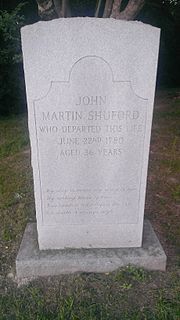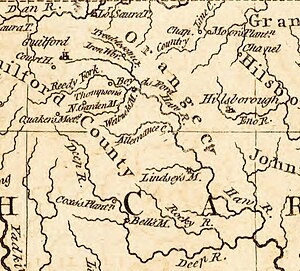Francis Nash was a brigadier general in the Continental Army during the American Revolutionary War. Prior to the war, he was a lawyer, public official, and politician in Hillsborough, North Carolina, and was heavily involved in opposing the Regulator movement, an uprising of settlers in the North Carolina piedmont between 1765 and 1771. Nash was also involved in North Carolina politics, representing Hillsborough on several occasions in the colonial North Carolina General Assembly.

Thomas Burke was an Irish physician, lawyer, and statesman who lived in Hillsborough, North Carolina. He represented North Carolina as a delegate to the Continental Congress and was the third Governor of the state.

The Battle of Kings Mountain was a military engagement between Patriot and Loyalist militias in South Carolina during the Southern Campaign of the American Revolutionary War, resulting in a decisive victory for the Patriots. The battle took place on October 7, 1780, 9 miles (14 km) south of the present-day town of Kings Mountain, North Carolina. In what is now rural Cherokee County, South Carolina, the Patriot militia defeated the Loyalist militia commanded by British Major Patrick Ferguson of the 71st Foot. The battle has been described as "the war's largest all-American fight".

Joseph "Quaker Meadows" McDowell Jr. was an American planter, soldier, and statesman from North Carolina. He was known as "Quaker Meadows Joe" to distinguish him from his cousin Joseph "Pleasant Gardens" McDowell, who was also a legislator and American Revolutionary War officer from North Carolina. The two men are not always clearly distinguished in historical records; both were in the 1780 Battle of Kings Mountain, one as a major in the Burke County Regiment of the North Carolina militia, and the other in a subordinate role as a captain.

Edmund Fanning was a British North American colonial administrator and military leader. Born in New York, he became a lawyer and politician in North Carolina in the 1760s. He first came to fame as the focus of hatred of the Regulators, and led anti-Regulator militia in the War of the Regulation. When the American Revolutionary War broke out, he was driven from his home in New York, and joined the British Army, recruiting other Loyalists. He served during campaigns in New England and the South. At the end of the war in 1783 he became a United Empire Loyalist, settling in Nova Scotia.

The Battle of Kettle Creek was a minor encounter in the back country of Georgia during the American Revolutionary War that took place on February 14, 1779. It was fought in Wilkes County about eight miles (13 km) from present-day Washington, Georgia. A militia force of Patriots decisively defeated and scattered a Loyalist militia force that was on its way to British-controlled Augusta.

The Battle of Moore's Creek Bridge was a minor conflict of the American Revolutionary War fought near Wilmington, North Carolina, on February 27, 1776. The victory of the North Carolina Provincial Congress' militia force over British governor Josiah Martin's reinforcements at Moore's Creek marked the decisive turning point of the Revolution in North Carolina. American independence would be declared less than five months later.
Pyle's Massacre, also known as Pyle's Hacking Match or the Battle of Haw River, was fought during the American Revolutionary War in Orange County, North Carolina, on February 24, 1781, between Patriot and Loyalist North Carolina militia troops. Patriot cavalry commander Continental Army Colonel Henry Lee surprised Loyalist militia under Dr. John Pyle, who thought Lee was the British cavalry commander Banastre Tarleton sent to meet Pyle. Lee's men then opened fire, surprising and scattering Pyle's force, with Colonel Lee pursuing Tarleton in the direction of Hillsborough, NC, intending to capture or kill his command.

The Southern theater of the American Revolutionary War was the central theater of military operations in the second half of the American Revolutionary War, 1778–1781. It encompassed engagements primarily in Virginia, Georgia and South Carolina. Tactics consisted of both strategic battles and guerrilla warfare.
The Hillsborough District Brigade of militia was an administrative division of the North Carolina militia established on May 4, 1776. Brigadier General Thomas Person was the first commander. Companies from the eight regiments of the brigade were engaged in 55 known battles and skirmishes in North Carolina, South Carolina, and Georgia during the American Revolutionary War. It was active until the end of the war.

David Fanning was a Loyalist leader in the American Revolutionary War in North and South Carolina. Fanning participated in approximately 36 minor engagements and skirmishes, and in 1781, captured the Governor of North Carolina, Thomas Burke, from the temporary capital at Hillsborough. Additionally, Fanning was captured by Patriot forces 14 times throughout the war, each time escaping or receiving a pardon. After the British defeat in the war, Fanning fled to Canada, where he was elected to the Legislative Assembly of New Brunswick from 1791 to 1801 representing Kings County. After being convicted of rape in 1801, Fanning was expelled from New Brunswick, and settled in Nova Scotia, where he lived the remainder of his life.

Griffith Rutherford was an officer in the American Revolutionary War, a political leader in North Carolina, and an important figure in the early history of the Southwest Territory and the state of Tennessee.

The Battle of Ramsour's Mill took place on June 20, 1780 in present-day Lincolnton, North Carolina, during the British campaign to gain control of the southern colonies in the American Revolutionary War. The number of fighters on each side of the battle is still an issue of contention, but Loyalist militiamen outnumbered Patriot militia and had captured a group of Patriots who they were planning to hang on the morning of June 20.

The Battle of Musgrove Mill, August 19, 1780, occurred near a ford of the Enoree River, near the present-day border between Spartanburg, Laurens and Union Counties in South Carolina. During the course of the battle, 200 Patriot militiamen defeated a combined force of approximately 300 Loyalist militiamen and 200 provincial regulars.
Jonathan Lindley (1756–1828) was an 18th-century member of the North Carolina legislature, land speculator, and one of the original settlers of Orange County, Indiana.
James Moore was a Continental Army general during the American Revolutionary War. Born into a prominent political family in the colonial Province of North Carolina, he was one of only five generals from North Carolina to serve in the Continental Army. Moore spent much of his childhood and youth on his family's estates in the lower Cape Fear River area, but soon became active in the colonial military structure in North Carolina.

The Battle of Alamance, which took place on May 16, 1771, was the final battle of the War of the Regulation, a rebellion in colonial North Carolina over issues of taxation and local control, considered by some to be the opening salvo of the American Revolution. Named for nearby Great Alamance Creek, the battle took place in what was then Orange County and has since become Alamance County in the central Piedmont area, about 6 miles (9.7 km) south of present-day Burlington, North Carolina.
John Butler was a military officer in the Hillsborough District Brigade of the North Carolina militia during the American Revolutionary War from 1775 to 1784, and served as its commanding general between 1779 and the end of the conflict. He was a member of the North Carolina House of Commons for several terms simultaneously with his military service. Butler commanded soldiers in several major engagements throughout North and South Carolina, but is perhaps best remembered for his role in the Patriot defeat at the Battle of Lindley's Mill. Butler died shortly after the end of the war, and his career as a military commander has received mixed reviews by historians.
Thomas Eaton was a military officer in the North Carolina militia during the War of the Regulation in 1771 and American Revolutionary War from 1775 to 1784. He was a member of the North Carolina Provincial Congress and North Carolina House of Commons for several terms simultaneously with his military service. Eaton was a member of the North Carolina Council of State under Governor Richard Caswell. Eaton commanded soldiers in the battles of Brier Creek and Guilford Courthouse. At the time of the 1790 census, Eaton was one of the largest slaveholders in North Carolina.
Thomas Wade (1720–1786) was a merchant, commander of the Anson County Regiment of North Carolina militia during the American Revolution, and senator from Anson County in the North Carolina Provincial Congress and General Assembly. Wadesboro, North Carolina was named for him.












